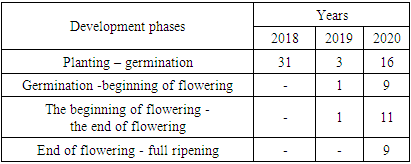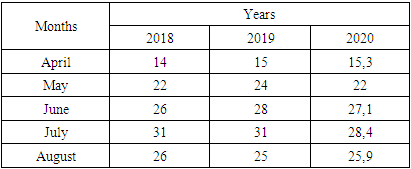-
Paper Information
- Paper Submission
-
Journal Information
- About This Journal
- Editorial Board
- Current Issue
- Archive
- Author Guidelines
- Contact Us
International Journal of Virology and Molecular Biology
p-ISSN: 2163-2219 e-ISSN: 2163-2227
2023; 12(3): 35-39
doi:10.5923/j.ijvmb.20231203.01
Received: Aug. 28, 2023; Accepted: Sep. 20, 2023; Published: Sep. 23, 2023

Assessment of the Influence of Environmental Factors on the Development Phases of Soybean Varieties
Rakhimova Holisxon Maksudovna1, Allashukurov Sherzhan Razzakovich2, Bobojonova Gulnoza Farhodovna3
1PhD., Urgench State University, Urgench, Uzbekistan
2Lecturer, Department of Biology, Urgench State University, Urgench, Uzbekistan
3Master Degree Student, Urgench State University, Urgench, Uzbekistan
Correspondence to: Rakhimova Holisxon Maksudovna, PhD., Urgench State University, Urgench, Uzbekistan.
| Email: |  |
Copyright © 2023 The Author(s). Published by Scientific & Academic Publishing.
This work is licensed under the Creative Commons Attribution International License (CC BY).
http://creativecommons.org/licenses/by/4.0/

Effect of air temperature and precipitation of external environmental factors on the growth and development of different varieties of soybean are studied in the article. This framework allows to determine in which soils soybean varieties can grow, to obtain high yields based on environmental requirements for the external environment.
Keywords: Soy, Variety, Weather, Temperature, Plant, Seed, Soil, Saline
Cite this paper: Rakhimova Holisxon Maksudovna, Allashukurov Sherzhan Razzakovich, Bobojonova Gulnoza Farhodovna, Assessment of the Influence of Environmental Factors on the Development Phases of Soybean Varieties, International Journal of Virology and Molecular Biology, Vol. 12 No. 3, 2023, pp. 35-39. doi: 10.5923/j.ijvmb.20231203.01.
Article Outline
1. Introduction
- An economic and social crisis are happening in the world today and it is necessary to study the ecological and biological basis of plant development in order to properly regulate the production in the agro-industry to provide society with food. Today, in Uzbekistan, like all other sectors, is on the path of modernization in agriculture [1,2]. Providing the growing population with quality food products, increasing soil fertility and ecologically plastic crops that can grow in saline soils will allow to obtain higher yields, and therefore the study of ecology and biology of soybean cultivation in Khorezm region is one of the most important tasks.
2. Literature Analysis on the Subject
- Indicators such as the height of soybean varieties and what type they belong to indicate that a particular variety is suitable for planting in a certain area, says S.V.Zelentsov and proved in their experiments that the determinant soybean varieties are less productive, their flowering phases are very short. The scientist observed that under stress conditions the flowering phase in determinate soybean varieties is further shortened and yields are reduced to 7-9 percent, stress conditions are observed in the shedding of reproductive organs [3,7,10]. Number of scientists, such as Zhuchenko, A.A., Korzun, A.S., Torikov, V.E., Konstantinova O.B. have come to the conclusion that ecological plasticity in soybean varieties means their adaptation to the external environment according to their biological properties [4,5,6,7].Effect of external factors in the care of soybean varieties can be felt at all stages of development, says D. Yormatova [11].
3. Materials and Methods
- Our research was conducted in the experimental fields of Khorezm Scientific Experimental Station of the Seed and Cultivation Agrotechnologies Scientific Research Institute of the Khorezm region. In experiments, all observations and analyzes were carried out on the basis of the methodical manual of UzPITI (2007), B.A. Dospekhov “Methodology of field experiment” (1985) [8].In the experiment, Nafis st from State Registers, Selekta – 3 from Parvoz and Russian selection and Eureka-357 of Kazakh selection planted in 3 different seedling thicknesses (seedling thickness 3 cm, 4 cm and 5 cm). The experiment was carried out in the field method in 3 repetitions. The agro-techniques of the field experiment were carried out in a timely and quality manner, taking into account the natural climatic conditions of the farm. In field experiments phenological observations and agro-technical measures were carried out in various accounts. Observations and calculations were made from plants that meet the requirements of the growth of soybean varieties grown in the experimental variants, the most efficient ratio of yield organs, compactness of the bush and non-lying.The number of plants was obtained for observation in each section of all repetitions as follows:- for counting seedlings of soybean varieties - at least 100 nests were obtained;- for counting the height of the plant, the leaves and the number of branches from 50 bushes; - budding, flowering and counting the resulting pods for 30 bushes;- for the general account of beans birth-taken from 60 bushes. The seedlings were counted in three periods: when the seedlings began to appear, when the seedlings sprouted, and when they sprouted completely.Measurement of the height of the main stem was carried out every 15 days after germination.After the formation of additional branches on the main stem and the resulting leaves were also counted every 15 days.
4. Results and Discussions
- The most important factor in the care of soybean varieties is the resistance or adaptation of varieties to the external ecological environment, especially in our harsh continental climate, the importance of external factors is very high. Scientific research on the ecological plasticity or adaptation of plants to the external environment has been conducted for a very long time. There are several methods for assessing the ecological plasticity or resilience of plants to external stressors. Ecological plasticity of soybean varieties means that it adapts to unfavorable external conditions and yields during the growing season. The territory of the Khorezm oasis is divided into two parts according to the nature of the relief and soil genesis: the first is the southern plain of the old Amu Darya and the second is the lowland of the south-western Qaraqum. The general slope of the plain is not very large, 0.00015-0.00025 mm-1 flowing from the Amu Darya to the Karakum to the west, northwest and southwest. The main irrigation networks of the oasis are spread in this direction. Micro and mesorelief vary by approximately 0.005 mm-1 [9]. The highest point of the plain is the plains of the Amu Darya, 113-138 meters above sea level, around Khazarasp district and the city of Manḡit. The lowest point of the oasis is Lake Korp in Khiva district, which is 112 meters above sea level [10].The climatic conditions of Khorezm region are sharply continental. Because summers are very hot and winters are cold. This can be clearly seen from the data provided by the Urgench Hydrometeorological Service. As we mentioned above, the sharp continental temperature this summer was + 25.4-29.5°C in June-July, while the cold was 1.8-0.1°C in December-January. The strong variability of air temperature is one of the climatic conditions specific to this region. The growth, development, and yield of agricultural crops depend more on the intensity and distribution of precipitation during the growing season, rather than during the year, but at one or another critical stage of plant development.Rainfall in the experimental area mainly lasts from November to April-May.Precipitation levels (mm) by stage of development show that the 3 years from the year of the experiment to 2020 were particularly favorable (Urgench HMS). Rainfall during full flowering played a particularly decisive role. The remaining (2018, 2019) years of research showed low rainfall for flowering and seed maturation. Especially in 2018, no precipitation was observed at all during the flowering beginning, end of flowering and full ripening phases. In 2019, compared to 2018, less precipitation was observed in the beginning and end of flowering phases (Urgench GMS 1,1) (Table 1).
|
|
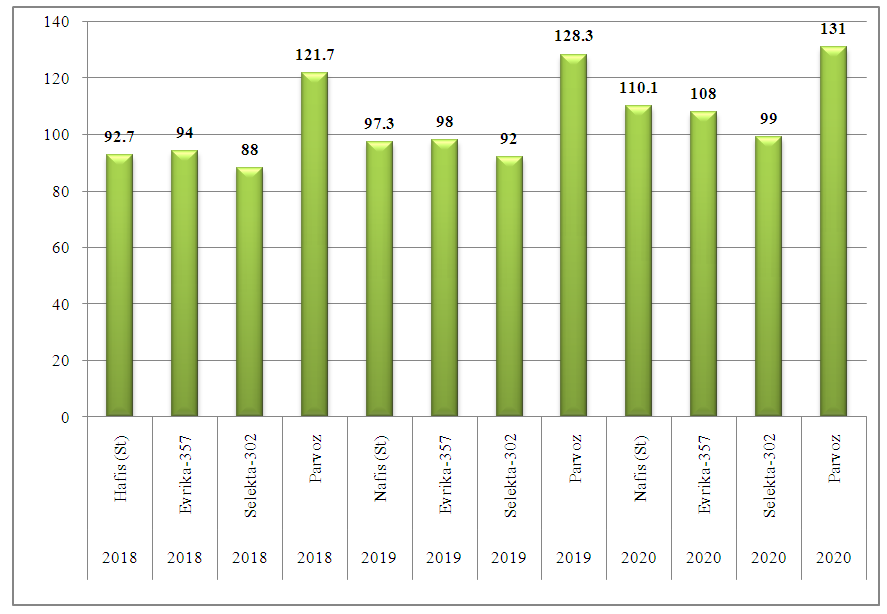 | Figure 1. Influence of abiotic factors on stem growth of different soybean varieties (seedling thickness 5 cm) |
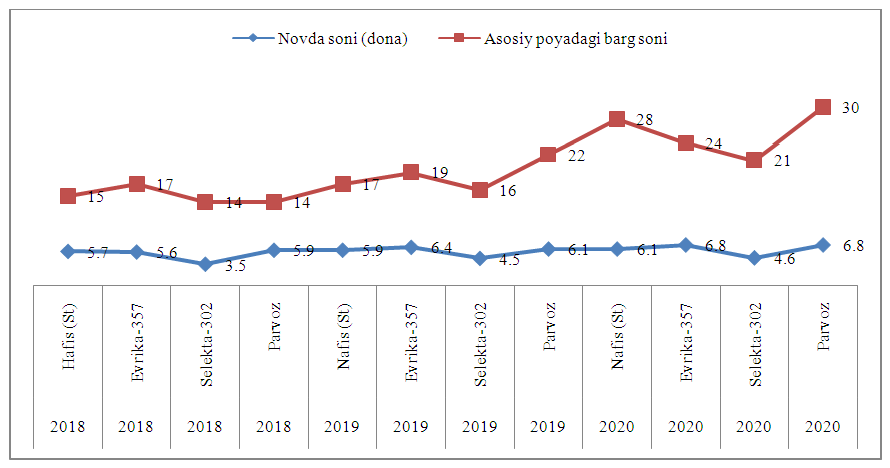 | Figure 2. Influence of abiotic factors on the development of branches and leaves in different soy varieties (seedling thickness 5 cm) |
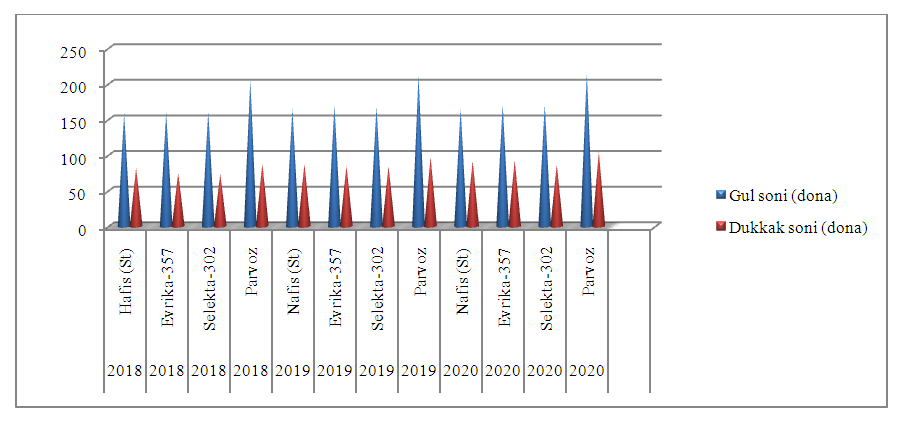 | Figure 3. Influence of abiotic factors on the formation of flowers and branches in different soybean varieties (seedling thickness 5 cm) |
5. Conclusions
- 1. According to the studied literature, soybean belongs to the legume family and differs from other legumes by its ecological plasticity.2. Abiotic factors have been shown to affect the growth of soybean stem varieties. In years when moisture and heat were sufficient, the stem length increased. This in turn had a positive effect on the yield performance of the soybean crop. 3. The productivity of the soybean plant depended on many components, the main part of which was the number of branches, the number of flowers and pods in them, the number of seeds in the pod. These indicators were significantly affected by weather conditions during the growing season. 4. The most sensitive stages of soybean development to environmental abiotic factors are the onset of flowering and legume formation. In the conditions of a sharp drop in temperature or the onset of drought in the soil and air, there was a shedding of flowers and falling of beans.
 Abstract
Abstract Reference
Reference Full-Text PDF
Full-Text PDF Full-text HTML
Full-text HTML